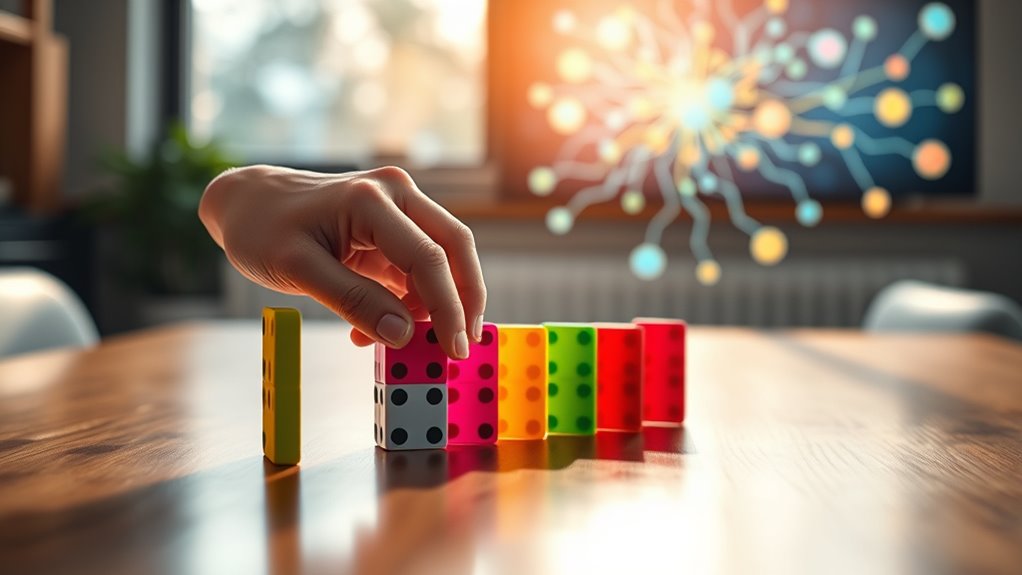Habit stacking works because it strengthens the neural pathways in your brain, making new behaviors easier over time. When you link actions, you activate your brain’s plasticity, rewiring circuits for efficiency. Reward signals like dopamine reinforce these habits, encouraging repetition. Existing habits serve as cues, reducing effort and mental load. As you stay consistent, these neural connections become stronger and automatic. Keep exploring, and you’ll discover even more about harnessing your brain’s incredible capacity for change.
Key Takeaways
- Habit stacking strengthens neural pathways by linking actions, facilitating easier and more automatic behavior over time.
- Linking habits triggers dopamine release, reinforcing positive behaviors and creating a reward-driven cycle that accelerates habit formation.
- Existing habits serve as cues, reducing cognitive effort and leveraging neural shortcuts to initiate new routines effortlessly.
- Repeatedly practicing stacked habits reinforces neural connections, making behaviors more ingrained and requiring less conscious effort.
- Brain neuroplasticity enables efficient rewiring of neural circuits through consistent habit stacking, promoting lasting behavioral change.

Habit stacking leverages the brain’s natural ability to link actions together, making it easier to build new routines. When you connect a new habit to an existing one, your brain forms stronger neural pathways that facilitate smoother execution over time. This process taps into the brain’s plasticity, allowing you to rewire your neural circuits with less effort than starting from scratch. Each time you successfully complete the linked habits, your brain experiences a surge of dopamine release—a neurotransmitter associated with pleasure and reward. This dopamine boost reinforces the behavior, encouraging you to repeat it. Over time, these reinforced neural pathways become more automatic, transforming intentional effort into habitual action.
As you practice habit stacking, you fundamentally create a mental shortcut. Your brain recognizes the initial cue—the existing habit—as a trigger for the new one, reducing the cognitive load involved in initiating the behavior. This reduced effort is partly because your brain has already established a robust neural pathway connecting the two actions. The dopamine release not only makes you feel good but also signals to your brain that this behavior is valuable, increasing the likelihood that you’ll stick with it. This positive reinforcement accelerates the formation of a new habit, making it feel almost effortless.
The strength of these neural pathways depends on consistency. When you consistently perform the linked habits, the neural connections grow stronger, leading to faster response times and more automatic behavior. This is why habit stacking is so effective—it leverages existing neural structures, making the process of habit formation more efficient than creating new pathways from scratch. Each successful repetition reinforces the dopamine-driven reward system, further embedding the habit into your daily routine. Over time, the behavior becomes an ingrained part of your subconscious, requiring less conscious effort.
In essence, habit stacking utilizes the brain’s natural wiring—its neural pathways—by creating deliberate connections that are reinforced through dopamine release. This biological mechanism explains why some habits seem to stick effortlessly once they’re linked to existing routines. Additionally, understanding the neuroplasticity of the brain highlights how adaptable our neural circuits are and emphasizes the importance of consistent practice in habit formation. The process taps into your brain’s reward system, making the formation of new habits faster and more sustainable. By understanding this neuroscience, you can intentionally design your routines to harness these natural processes, massively increasing your chances of lasting change. When you connect new behaviors to existing ones, you’re not just forming habits—you’re rewiring your brain in a way that makes positive changes more natural and enduring.
Frequently Asked Questions
Can Habit Stacking Work for Overcoming Deep-Seated Emotional Triggers?
Habit stacking can help you manage deep-seated emotional triggers by strengthening emotional resilience and improving trigger management. When you link new, positive habits to existing routines, you create a supportive framework that gradually rewires your brain. Over time, this makes it easier to respond calmly instead of react impulsively. Consistent habit stacking empowers you to break negative patterns, building emotional strength and resilience against triggers that once held you back.
How Does Habit Stacking Influence Brain Plasticity Over Time?
Habit stacking influences your brain by promoting neuroplasticity enhancement and synaptic remodeling over time. When you consistently connect new habits to existing ones, your brain strengthens relevant neural pathways, making these behaviors more automatic. This repeated activation encourages synaptic remodeling, which rewires your brain for lasting change. As a result, your brain becomes more adaptable, helping you form new habits faster and sustain positive changes even during challenges.
Are There Specific Brain Regions Involved in Habit Stacking Processes?
You wonder if specific brain regions are involved in habit stacking. When you engage in habit stacking, neural pathways linked to routines strengthen through synaptic plasticity. The basal ganglia play a key role in habit formation, helping automate behaviors, while the prefrontal cortex manages planning and decision-making. Together, these regions coordinate to reinforce the neural pathways necessary for seamless habit stacking, leading to lasting behavioral change.
What Role Does Dopamine Play in Reinforcing Habit Stacks?
Oh, dopamine, the tiny cheerleader of your brain, steps in to make habit stacking addictive. It activates dopamine pathways in your reward system, signaling, “Hey, that was good—do it again!” Each successful habit reinforces itself, making future stacks easier. So, you can thank dopamine for turning your new routines into delightful, craving-worthy rituals that keep you hooked on progress—one rewarding step at a time.
Can Habit Stacking Help Improve Cognitive Functions Like Memory?
Habit stacking can boost your cognitive functions like memory by strengthening neural pathways through repeated routines. When you build habits that challenge your brain, you promote cognitive enhancement, making it easier to recall information. By consistently pairing new activities with existing ones, you create a seamless process that reinforces neural connections. Over time, this practice helps improve your memory and overall cognitive performance, making it a practical strategy for mental growth.
Conclusion
By stacking habits, you’re planting seeds in your brain’s fertile ground, each new action becoming a crucial root anchoring your growth. Like a master gardener tending a thriving garden, you nurture small changes, knowing they’ll blossom into lasting transformation. Remember, every habit is a drop in the ocean of your potential. Embrace this cycle, and watch your life evolve—one meaningful act at a time—until your habits become the steady tide shaping your destiny.










